
Helene Bertha Amalie Riefenstahl was a German director, producer, screenwriter, editor, photographer and actress known for producing Nazi propaganda.

Triumph of the Will is a 1935 German Nazi propaganda film directed, produced, edited and co-written by Leni Riefenstahl. Adolf Hitler commissioned the film and served as an unofficial executive producer; his name appears in the opening titles. It chronicles the 1934 Nazi Party Congress in Nuremberg, which was attended by more than 700,000 Nazi supporters. The film contains excerpts of speeches given by Nazi leaders at the Congress, including Hitler, Rudolf Hess and Julius Streicher, interspersed with footage of massed Sturmabteilung (SA) and Schutzstaffel (SS) troops and public reaction. Its overriding theme is the return of Germany as a great power with Hitler as its leader. The film was produced after the Night of the Long Knives, and many formerly prominent SA members are absent.
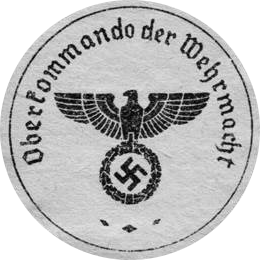
The Oberkommando der Wehrmacht was the supreme military command and control office of Nazi Germany during World War II. Created in 1938, the OKW replaced the Reich Ministry of War and had oversight over the individual high commands of the country's armed forces: the army, navy, and air force.

The Nuremberg rallies were a series of celebratory events coordinated by the Nazi Party in Germany. The first Nazi Nuremberg rally took place in 1923. This rally was not particularly large and did not have much impact; however, as the party grew in size, the rallies became more elaborate and featured larger crowds. They played a seminal role in Nazi propaganda events, conveying a unified and strong Germany under Nazi control. The rallies became a national event once Adolf Hitler rose to power in 1933, when they became annual occurrences. Once the Nazi dictatorship was firmly established, the party's propagandists began filming them for a national and international audience. Nazi filmmaker Leni Riefenstahl produced some of her best known work including Triumph of the Will (1934) and The Victory of Faith (1933), both filmed at the Nazi party rally grounds near Nuremberg. The party's 1938 Nuremberg rally celebrated the Anschluss that occurred earlier that year. The 1939 scheduled rally never came to pass and the Nazi regime never held another one as both the government and Nazi Party prioritized Germany's effort in the Second World War over everything else.
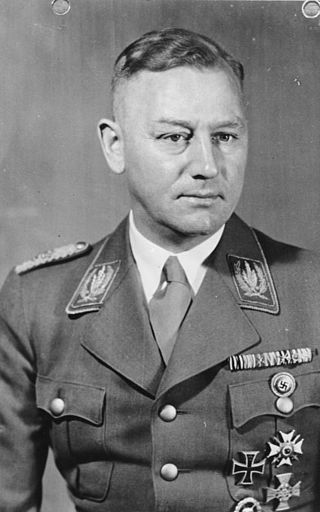
Viktor Lutze was a German Nazi Party functionary and the commander of the Sturmabteilung ("SA") who succeeded Ernst Röhm as Stabschef and Reichsleiter. After he died from injuries received in a car accident, Lutze was given an elaborate state funeral in Berlin on 7 May 1943.
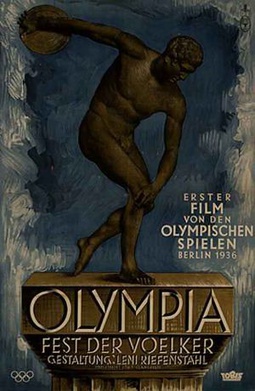
Olympia is a 1938 German documentary film written, directed and produced by Leni Riefenstahl, which documented the 1936 Summer Olympics, held in the Olympic Stadium in Berlin during the Nazi period. The film was released in two parts: Olympia 1. Teil — Fest der Völker and Olympia 2. Teil — Fest der Schönheit. The 1936 Summer Olympics torch relay, as devised for the Games by the secretary general of the Organizing Committee, Dr. Carl Diem, is shown in the film.

The flag of Nazi Germany, officially the flag of the German Reich, featured a red background with a black swastika on a white disc. This flag came into use initially as the banner of the Nazi Party (NSDAP) after its foundation. Following the appointment of Adolf Hitler as Chancellor in 1933, this flag was adopted as one of the nation's dual national flags, the other being the black-white-red triband of the German Empire.

Der Sieg des Glaubens is the first Nazi propaganda film directed by Leni Riefenstahl. Her film recounts the Fifth Party Rally of the Nazi Party, which occurred in Nuremberg, Germany, from 30 August to 3 September 1933. The film is of great historic interest because it shows Adolf Hitler and Ernst Röhm on close and intimate terms, before Hitler had Röhm shot during the Night of the Long Knives on 1 July 1934. As he then sought to erase Röhm from German history, Hitler required all known copies of the film to be destroyed, and it was considered lost until a copy turned up in the 1980s in East Germany.

The Nazi party rally grounds covered about 11 square kilometres in the southeast of Nuremberg, Germany. Six Nazi party rallies were held there between 1933 and 1938.
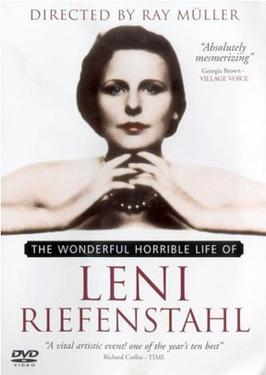
The Wonderful, Horrible Life of Leni Riefenstahl is a 1993 German documentary film about the life of German film director Leni Riefenstahl, directed by Ray Müller.
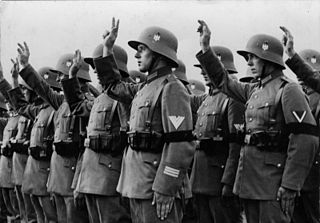
The Hitler Oath —also referred in English as the Soldier's Oath—refers to the oaths of allegiance sworn by the officers and soldiers of the German Armed Forces and civil servants of Nazi Germany between the years 1934 and 1945. The oath pledged personal loyalty to Adolf Hitler in place of loyalty to the constitution of the country. Historians view the personal oath of the Third Reich as an important psychological element to obey orders for committing war crimes, atrocities, and genocide. During the Nuremberg trials, many German officers unsuccessfully attempted to use the oath as a defense against charges of war crimes and crimes against humanity.
Herbert Windt was a German composer who became one of the most significant film score composers of the Third Reich. He was best known for his collaborations with the director Leni Riefenstahl on films Triumph of the Will and Olympia.
Der Marsch zum Führer is a Nazi propaganda film released in 1935. It depicts the nationwide march of Hitler Youth (HJ) to Nuremberg for the Nazi Party Rally. Unlike the earlier Leni Riefenstahl Nuremberg documentaries, it does not focus on the Party congress itself, or on Nazi leaders, who are not shown until the very end of the film. Instead, it follows HJ boys from various parts of Nazi Germany beginning their journey, camping along the route, being taken in by helpful families on the way and marching through cities in formation, saluting and carrying the swastika banner.
Festliches Nürnberg is a short 1937 propaganda film chronicling the Nazi Party rallies in Nuremberg, Germany in 1936 and 1937. The film was directed by Hans Weidemann.

The Documentation Center Nazi Party Rallying Grounds is a museum in Nuremberg. It is in the north wing of the unfinished remains of the Congress Hall of the former Nazi party rallies. Its permanent exhibition "Fascination and Terror" is concerned with the causes, connections, and consequences of Nazi Germany. Topics that have a direct reference to Nuremberg are especially taken into account. Attached to the museum is an education forum.

The Königgrätz March, also known as Der Königgrätzer or Der Königgrätzer Marsch, is one of the most famous German military marches, composed in 1866 by Johann Gottfried Piefke in commemoration of the Battle of Königgrätz, the decisive battle of the Austro-Prussian War, in which the Kingdom of Prussia defeated the Austrian Empire. In Piefke's most successful arrangement of the Königgrätzer Marsch, another march, Der Hohenfriedberger, is used as a trio. The commonly played version is set as an infantry march, while an alternate adaptation is arranged as a cavalry galop. The German military march catalogue also has the "Königgrätzer mit anderem Trio", but this secondary composition is far less recognized.

The Wehrmacht were the unified armed forces of Nazi Germany from 1935 to 1945. It consisted of the Heer (army), the Kriegsmarine (navy) and the Luftwaffe. The designation "Wehrmacht" replaced the previously used term Reichswehr and was the manifestation of the Nazi regime's efforts to rearm Germany to a greater extent than the Treaty of Versailles permitted.
Events in the year 1934 in Germany.

The War for Men's Minds is a 21-minute 1943 Canadian documentary film, made by the National Film Board of Canada (NFB) as part of the wartime The World in Action series. The film was produced by Stuart Legg. The film describes the impact of propaganda from the Axis powers in 1943, during the Second World War. The French version title is À la conquête de l'esprit humain.
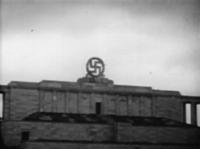
De Nuremberg à Nuremberg is a French documentary film about the Third Reich by Frédéric Rossif, with text written and read by Philippe Meyer, produced by Jean Frydman.
















